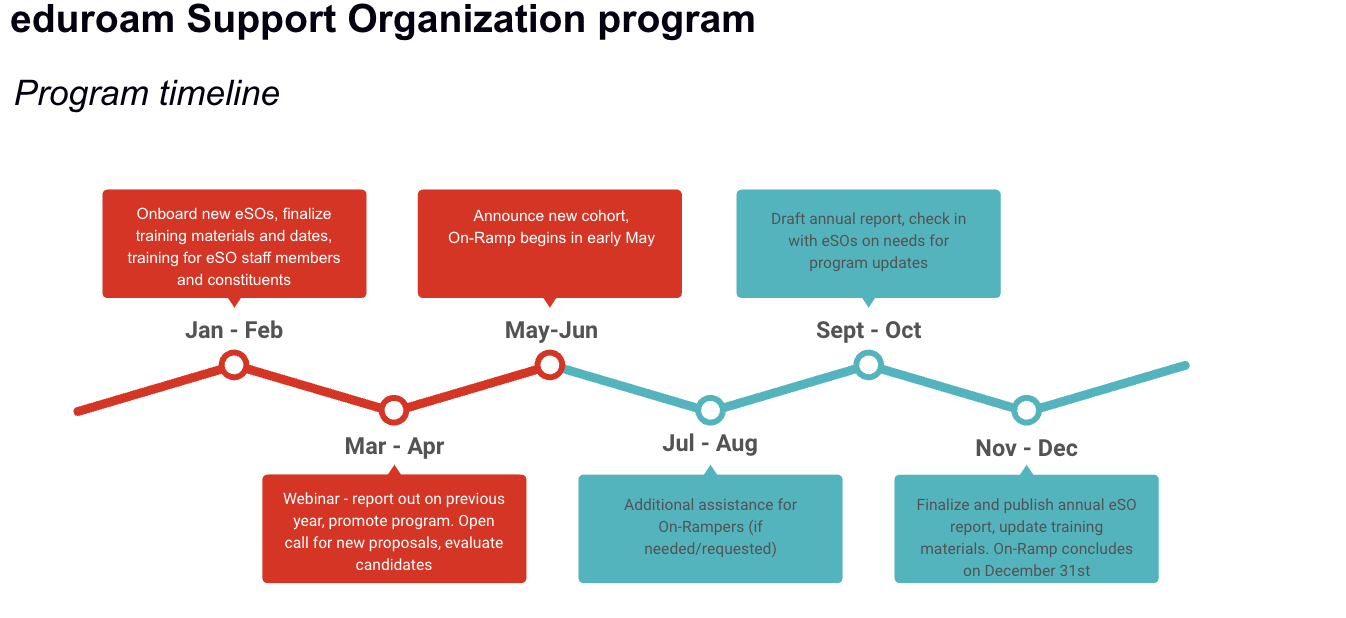
The true value of eduroam increases with its ubiquity. eduroam in every primary and secondary educational institution, library, and public space boosts the value proposition of the service immensely and regional networks and community anchor institutions present a unique and powerful partner to address this scaling issue. At the same time, this helps make community services, and the community that provides them, more sticky. K12s, as well as libraries and museums that are part of the K12 ecosystem, have thus far been underserved by eduroam in the US. eduroam Support Organizations (eSOs) leverage their existing relationships with K12s, libraries, and museums to address this need.
To better enable eduroam Support Organizations to serve these communities, Internet2 provides the eSOs with a simplified business model, training and resources to build the expertise of their staff, and ongoing support.
Key responsibilities of eduroam Support organizations include:
For an idea of what statewide deployments might look like for a eduroam Support Organization, we encourage you to read the annual reports generated by the program participants and Internet2:
Before your organization can become a full eduroam Support Organization you must go through the On-Ramp. When your proposal is accepted the On-Ramp begins! The On-Ramp is designed to provide an incoming eSO with an opportunity to develop the processes, resources, and relationships needed to succeed as they move toward full participation in the program. During this time we'll work with you to finalize the contracting portion of the eSO program, and you can participate with limited program features for the remainder of that calendar year. Your organization can sign up to five K12 districts, libraries, museums, or hotspot constituents. On-Rampers and their constituents will also have all program fees waived. After spending the May-December ramp-up period working with their pilot schools and gearing up for statewide deployments they will join the next Support Organization cohort on January 1st of the following year. There’s no need to sign additional agreements – "On-Rampers" will automatically become a full eduroam Support Organization, and will be invoiced at their state’s rate.

During the annual proposal window (typically held during the month of April) those interested in joining upcoming eduroam Support Organization Cohorts are expected to provide a presentation outlining plans for the deployment of eduroam K12 organizations within their state. The proposals are judged by the below criteria. Presentations are given to Internet2's staff, as well as current program participants, members of the eduroam Advisory Committee, and other volunteers from the community.
We ask that eduroam Support Organization candidates respond to each requirement and describe their organization's positioning for each. The top row shows how each High/Medium/Low readiness level is defined. These requirements will also be weighted. For example, a candidate’s response for “Serve K12s, libraries, museums” will carry a higher value than their response to “Using eduroam internally”.
| Organizational Requirements | High | Medium | Low |
|---|---|---|---|
Serve K12s, libraries, museums | Directly engages with these communities to provide network and other services. Directly connected to Internet2 and/or is the state's educational network | Has partnered with another organization or state government entity which engages with these communities to provide network and other services. Connects to Internet2 through another state network | No direct engagement with these communities |
Can ensure its constituents and their users abide by terms of agreement | Existing contracts with K-12 in state/region, can sign agreements on behalf of K-12 | Some contracts for services provided to K-12s in state/region | No vehicle for monitoring compliance |
Using eduroam internally | Yes | Rolling eduroam out | Joining now |
Additional factors which make your organization a good fit for the program | All/most of the “Medium” and… Experience with IAM, partnership or operational connection with state educational departments | Engagement on Regional calls, Existing relationship with Internet2 (e.g. network connection, participation in CAP, NET+ service engagements…) | N/A |
Planning Requirements | High | Medium | Low |
Roll-out team and roles identified and have cycles | Staff time is allocated in the following areas: help desk, identity management, wireless, documentation, and communication leads | Staff time is allocated in the following areas: help desk, identity management, wireless | Identified roles but are still assembling their team |
Early adopters identified and agree to take part in the plan | Adopters have piloted service and/or demonstrated interest | Provides a list of schools/districts that have expressed willingness to adopt | Provides list of possible adopters |
One or more eduroam pilots/implementations completed within your community | Existing contracts in place and implemented | One or more of your community members are in the process of provisioning service | None of your community members currently using eduroam |
High | Medium | Low | |
Wired network infrastructure
| More than 90% of the constituents meet the criteria | 60-89% of the constituents meet the criteria | Fewer than 60% of the constituents meet the criteria |
802.1x compliant wireless infrastructure
| More than 90% of the constituents meet the criteria | 60-89% of the constituents meet the criteria | Fewer than 60% of the constituents meet the criteria |
Identity store
| More than 90% of the constituents meet the criteria | 60-89% of the constituents meet the criteria | Fewer than 60% of the constituents meet the criteria |
RADIUS Server
| More than 90% of the constituents meet the criteria | 60-89% of the constituents meet the criteria | Fewer than 60% of the constituents meet the criteria |